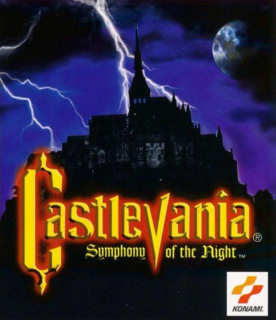Best. Castlevania. Game. Ever.
Symphony of the Night represents a huge break from the previous games in the Castlevania series. For starters, you no longer play as a whip-wielding Belmont. Instead, you control Alucard (son of Dracula, and previously seen as an optional character in the excellent Castlevania 3: Dracula’s Curse. Alucard’s main method of attack is a variety of equipable swords. Additionally, there are various pieces of armor, shields, capes, rings, talismans and other accoutrements that Alucard can equip to boost his offensive and defensive capabilities. Also, Alucard possesses various magical abilities that allow him to teleport, heal, shoot fire bolts, and transform into mist, a bat, or a wolf. In previous Castlevania games, the main character had a pre-determined lifebar, but Symphony offers stat building in the game. While playing through the game, Alucard’s hit points, magic points, strength, intelligence, etc. will all increase, making him more powerful and more able to deal with the menaces he encounters in the castle. Another huge difference in SOTN is the basic structure of the game. Previous Castlevania games (excluding Simon’s Quest) were all linear. Dracula’s Curse and Rondo of Blood offered branching paths, but the end destination was always the same. SOTN, on the other hand is modeled after the legendary Super Metroid for the SNES. The player is granted the freedom to explore the castle at will, and can complete portions of the game in whatever order he or she wishes (Up to a certain point. Certain areas of the castles require special objects or abilities to gain access and cannot be entered until other areas have been completed). The castle is huge and will take many hours to completely traverse. Fortunately, there is a built-in mapping system that will allow players to monitor their position in the castle. Throughout the castle, there are special save rooms that allow the player to regenerate health and save current progress. The game boasts several different endings, and also has a secret option to play as Richter Belmont (from Rondo of Blood) once completing the game as Alucard. The Saturn version of the game allows you to play as Alucard, Richter, or Maria (also from Rondo of Blood) right from the start, and also has two additional areas in the castle.
Graphics:
Some might call the graphics simple for a Playstation game, but the 2D sprites are well rendered with none of the flicker, clipping, or popup that affects many of the 3D PSX games. The character designs are fantastic, and the overall design of the castle is ingenious, with great little touches that add immeasurably to the creepy, gloomy atmosphere.
Sound:
As per usual with the Castlevania games, the music is outstanding, with this game being the standard-bearer for excellence in video game music. The music is eclectic and each piece is perfectly suited to the surrounding castle areas and situation at hand. As with pretty much every game in the series, there is a version of the classic “Vampire Killer” theme. The voice acting in the game is decent, ranging from the uninspired to the excellent.
Summation:
The Castlevania games had been classics in the video game world for many years when it came out, all of them excellent (with the somewhat mediocre port of Dracula X for the SNES, being the lone exception) but this game took the classic formula, trashed it, and reinvented the series as something different, something much grander. SOTN still has all of the action of the previous games, but added RPG elements to make the game a much deeper, richer experience. This game is a marvel and any Playstation collection that is missing it is sorely incomplete.

